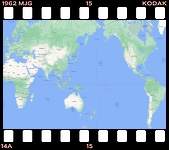Having expressed to the 2 Israelis my interest in climbing the nearby volcano, at 6 am I was duly woken by one of them: Yossi, an amiable albino with a mass of frizzy white hair. Some dense pancakes served by Aida, the owner of the hostel, got us on our way.
The summit of Imbabura is at 4634 m (15,203 ft) – a significant height, and only 300 m lower than the highest peak I have ever been up until now (Point Lenana on Mount Kenya in 1982). Since Casa Aida is at 2600 m the top of the volcano was a significant way above us, but not, apparently, impossible. A 2000 m climb is something I have occasionally done in one day in the UK and the Alps.
We set a fast pace – Yossi and Yoram had been in the army recently (apparently many Israelis go travelling immediately after their obligatory military service) so they were quite fit. However it wasn’t long before I was reminded why Mount Kenya had been so tough – the air got thinner and thinner as we left the valley and fields far below us. Once we reached about 4000m progress slowed to a crawl. Our bodies had long since used up the calories in Aida’s pancakes, and we hadn’t taken much to eat for lunch…
Though the summit didn’t look so very far above us, we were still below the rim when we reluctantly decided that enough was enough. We were all very tired, hungry, and unable to move with enough energy to maintain safety on the increasingly rocky and broken terrain. Above us the ground steepened before the rim in a series of steps. But from where we had reached the view was spectacular and we sat down to soak it all in and have a good long rest before worrying about the descent.
Though we were not on the rim proper, we could see into the crater since the rim was broken away on the south east side. To the south 2 snowcapped volcanos were visible – Nevado Cayembe was just 30 km away, with another volcano at least twice the distance to the right. Admiring the stunted but lush vegetation immediately around us was just as attractive as the distant views, and the way that the flora changed with altitude was fascinating.
Eventually we started the long descent to the valley. As we neared the upper farms where people were working and carrying produce, it became very clear indeed that I was in the Andes. The clothes worn by the women were very characteristic of what I had seen in TV documentaries, but hadn’t been sure if I would actually see in real life. But Andean dress was everywhere. The hats, the colourful embroidered skirts, the fact of carrying everything (including a baby or two) on the back using a length of cloth serving as a backpack – it was all too good to be true! I took a few candid shots of people…
Back at Casa Aida I took the rest of the afternoon off…
The hostel is very basic but is friendly and very cheap, and a classic backpackers’ hangout. Aida herself is quite a character, and after serving dinner to her backpacker guests she likes to tell stories of the more memorable predecessors of the current contingent.
The next day (10th December) the two Israelis departed for Ibarra to do the famous train trip that I had been hearing and reading about. This involves a very early start and a full day on what sounds like a very slow train down to the Pacific coast. This railway is the only way get down to the coast in northern Ecuador – there is no road. It sounds like rather a grueling adventure. The problem is that at Casa Aida there are only people who are about to do the trip, nobody who has actually done it. People leave to “do the train” but then nobody ever hears what happened, and if they made it…
I had a complete day off. There being almost 3 months before I am due to leave South America and didn’t feel any need to hurry away from somewhere where I was happy to be. I washed all my clothes – even the light weight trekking boots that I am basically wearing the whole time.
I got chatting again to a couple consisting of an Irish Australian called Tim and his British girlfriend called Liz. They were on a very tight budget and were dependent on simple places like Casa Aida to be able to travel at all. Later I got my short wave radio out and Tim and Liz listened in fascination to the BBC News-hour program – they hadn’t heard any English speaking news for a long time. Later, through the thin wall, I overheard them enthusing about it in their room, which was next to mine. How great to be able to carry a radio like that, one of them commented, and keep informed. Yes, said the other one, but $300 is over a month of travel….
The following day (11th December) I spend as much time as I could being bone idle, reading, writing letters, and chatting. Finally I checked out and caught the local bus the short distance to Ibarra, where I located the railway station and checked in to the nearby and fancifully named Hotel Astoria. A nice hot shower, a nearby Chinese meal, and an early night were required.
This was because it was now my turn to “do the train”…

